Assessment of Vegetation Cover and Rainfall Infiltration Effects on Slope Stability
Abstract
1. Introduction
2. Rainfall Infiltration Testing in Large-Scale Vegetated Slopes
2.1. Study Area
2.2. Soil Basic Parameters
2.3. Model Design
2.4. Vegetation Cultivation
3. Test Results and Analysis
3.1. Empirical Patterns of Spatiotemporal Variation in Slope Moisture Content
3.2. Empirical Patterns of Infiltration Rate and Cumulative Infiltration on Slope
4. Strength and Hydraulic Properties of Unsaturated Rooted Soil
4.1. Materials and Methods
4.2. Results
5. Stability Analysis of Slope Protected by Different Vegetation
5.1. Reliability Evaluation of Numerical Simulation—Model Establishment
5.2. Results Analysis
5.3. Stability Analysis of Slope Protected by Different Vegetation—Model Establishment
5.4. Results Analysis
6. Discussion
6.1. Effects of Vegetation on Slope Rainfall Infiltration
6.2. Effects of Vegetation on Slope Stability
6.3. Limitation
7. Conclusions
- Under rainfall conditions, the infiltration rate of the slope exhibits significant spatial variability. The peak rainfall infiltration rates for all four types of slopes occur at a burial depth of 0.2 m, gradually decreasing with increasing burial depth. Various types of vegetation have distinct impacts on the regulation of a slope’s infiltration capacity. The presence of herbaceous and mixed vegetation encourages rainfall infiltrate, resulting in a significant increase in cumulative infiltration by 21.32% and 77.07%, compared to the bare slope. In contrast, the infiltration rate and cumulative infiltration of shrub slope are lower than that of bare slope, leading to a decrease in cumulative infiltration by 61.06%.
- When the moisture content was the same, the mixed roots soil had the highest shear strength, followed by shrub, herbaceous and bare soil. As the moisture content increased, the shear strength gradually decreased. Under elevated water content conditions, root systems exhibit a substantially stronger enhancement effect on soil cohesion compared to the improvement in internal friction angle.
- The enhancement effect of vegetation on slope stability varies significantly depending on vegetation type. Before rainfall, the shrub slope exhibited the highest safety factor, reaching 3.046, followed by the mixed slope (2.948) and the herbaceous slope (2.81). The safety factors for the shrub, mixed and herbaceous slopes increased by 0.280, 0.182 and 0.044, compared to the bare slope’s safety factor of 2.766. This difference is primarily due to the lower initial moisture content of the shrub slope, resulting in a more substantial increase in shear strength parameters and ultimately leading to a higher safety factor than the mixed slope.
- As rainfall continues, the moisture content within each slope gradually tends towards saturation, reducing the differences between them. After rainfall, the mixed slope exhibits the highest safety factor at 1.361, followed by the shrub slope (1.275) and the herbaceous slope (1.192), The safety factors for the mixed, shrub and herbaceous slopes increased by 0.222, 0.136 and 0.053, compared to the bare slope’s safety factor of 1.139. Therefore, under the experimental conditions, the mixed herb–shrub vegetation scheme showed a potential synergistic effect.
Author Contributions
Funding
Institutional Review Board Statement
Informed Consent Statement
Data Availability Statement
Acknowledgments
Conflicts of Interest
References
- Glade, T.; Anderson, M.G.; Crozier, M.J. Landslide Hazard and Risk; Wiley Online Library: Hoboken, NJ, USA, 2005. [Google Scholar]
- Schuster, R.L.; Highland, L.M. The Third Hans Cloos Lecture. Urban landslides: Socioeconomic impacts and overview of mitigative strategies. Bull. Eng. Geol. Environ. 2007, 66, 1–27. [Google Scholar] [CrossRef]
- Salciarini, D.; Fanelli, G.; Tamagnini, C. A probabilistic model for rainfall-induced shallow landslide prediction at the regional scale. Landslides 2017, 14, 1731–1746. [Google Scholar] [CrossRef]
- Zhang, J.; Qiu, H.; Tang, B.; Yang, D.; Liu, Y.; Liu, Z.; Ye, B.; Zhou, W.; Zhu, Y. Accelerating effect of vegetation on the instability of rainfall-induced shallow landslides. Remote Sens. 2022, 14, 5743. [Google Scholar] [CrossRef]
- Chirico, B.G.; Borga, M.; Tarolli, P.; Rigon, R.; Preti, F. Role of vegetation on slope stability under transient unsaturated conditions. Procedia Environ. Sci. 2013, 19, 932–941. [Google Scholar] [CrossRef]
- Ruangpan, L.; Vojinovic, Z.; Di Sabatino, S.; Leo, L.S.; Capobianco, V.; Oen, A.M.P.; McClain, M.E.; Lopez-Gunn, E. Nature-based solutions for hydro-meteorological risk reduction: A state-of-the-art review of the research area. Nat. Hazards Earth Syst. Sci. 2020, 20, 243–270. [Google Scholar] [CrossRef]
- Tongsan, L.; Bao, H.; Lan, H.X.; Zheng, H.; Yan, C.G.; Peng, J.B. Hydro-mechanical effects of vegetation on slope stability: A review. Sci. Total Environ. 2024, 171691, 0048–9697. [Google Scholar] [CrossRef]
- Federico, P.; Vittoria, C.; Paola, S. Soil and Water Bioengineering (SWB) is and has always been a nature-based solution (NBS): A reasoned comparison of terms and definitions. Ecol. Eng. 2022, 181, 106687. [Google Scholar] [CrossRef]
- Cerdà, A. The influence of geomorphological position and vegetation cover on the erosional and hydrological processes on a Mediterranean hillslope. Hydrol. Process. 1998, 12, 661–671. [Google Scholar] [CrossRef]
- Michael, T.L.; Clemens, G.; Camilla, W.; Stefan, Z. The influence of herbaerous vegetation on slopo stability—A review. Earth-Sci. Rev. 2020, 209, 103328. [Google Scholar] [CrossRef]
- Marzini, L.; Papasidero, M.P.; D’Addario, E.; Schwarz, M.; Disperati, L. Exploring the relationship between saturated hydraulic conductivity and roots distribution: Two case studies in Garfagnana (Northem Tuscany, Italy) and Zollikofen (Bern, Switzerland). Front. Sustain. 2025, 6, 1631482. [Google Scholar] [CrossRef]
- Marzini, L.; D’Addario, E.; Papasidero, M.P.; Chianucci, F.; Disperati, L. Influence of root reinforcement on shallow landslide distribution: A case study in Garfagnana (Northem Tuscany, Italy). Geosciences 2023, 13, 326. [Google Scholar] [CrossRef]
- Wu, H.W.; Chen, S.Y.; Pang, Y.W. Parametric study of effects of rain infiltration unsaturated slope. Rock Soil Mech. 1999, 20, 1–14. [Google Scholar] [CrossRef]
- Nguyen, D.T.; Dau, N.V.; Ta, D.Q. The effects of rainfall on the stability of soil slopes in Khanh Vinh district, Khanh Hoa province. Sci. Technol. Dev. J. 2016, 19, 45–58. [Google Scholar] [CrossRef]
- Qi, G.Q.; Hu, L.W. Study on mechanism and application of slope protection with vegetation. Chin. J. Rock Mech. Eng. 2006, 25, 2220–2225. [Google Scholar] [CrossRef]
- Ng, C.W.W.; Ni, J.J.; Leung, K.A.; Zhou, C.; Wang, Z.J. Effects of planting density on tree growth and induced soil suction. Géotechnique 2016, 66, 711–724. [Google Scholar] [CrossRef]
- Mao, Z.J.; Zhang, J.G.; Bi, Y.L.; Sun, W.B.; An, N. Numerical analysis of the time effect of purple clover on shallow damage protection of loess slopes. Trans. Chin. Soc. Agric. Eng. 2022, 38, 72–83. [Google Scholar] [CrossRef]
- Yang, W.Z.; Han, S.F. Soil water ecological environment on the man-made woodland and grassland in loess hilly region. Mem. Niswc Acad. Sin. 1985, 2, 18–28. [Google Scholar]
- Leung, T.F.; Yan, W.M.; Hau, C.B.; Tham, L.G. Root systems of native shrubs and trees in Hong Kong and their effects on enhancing slope stability. Catena 2015, 125, 102–110. [Google Scholar] [CrossRef]
- Yu, Q.; Qiao, N.; Lu, H.; Hu, X.; Li, G.; Zhu, H. Effect study of plant roots reinforcement on soil. Chin. J. Rock Mech. Eng. 2012, 31, 3216–3223. [Google Scholar]
- Yildiz, A.; Graf, F.; Springman, S.M. An investigation of plant-induced suction and its implications for slope stability. Proc. Inst. Civ. Eng.-Geotech. Eng. 2019, 172, 520–529. [Google Scholar] [CrossRef]
- Yi, H.J.; Zhang, X.P.; He, L.; Zou, Y.D.; Lv, D.; Xu, X.M.; He, J.; Wang, Y.C.; Tian, Q.L. Vegetation restoration potential and land use change in different geomorphological areas of the Loess Plateau. Trans. Chin. Soc. Agric. Eng. 2022, 38, 255–263. [Google Scholar] [CrossRef]
- Cheng, P.; Li, J.H.; Song, L. Hydraulic and mechanical characteristics of ecological slopes: Experimental study. Chin. J. Geotech. Eng. 2017, 39, 1901–1907. [Google Scholar] [CrossRef]
- Ji, X.L.; Yang, P. The exploration of the slope displacement with vegetation protection under different rainfall intensity. J. For. Eng. 2020, 5, 127–133. [Google Scholar] [CrossRef]
- Kokutse, N.K.; Temgoua, A.G.T.; Kavazović, Z. Slope stability and vegetation: Conceptual and numerical investigation of mechanical effects. Ecol. Eng. 2016, 86, 146–153. [Google Scholar] [CrossRef]
- Xiao, T.; Li, P.; Hou, Y.F.; Liu, Y.M. A review of research on vegetated slope protection. J. Eng. Geol. 2019, 27, 379–385. [Google Scholar] [CrossRef]
- Tiwai, R.; Bhandary, N.; Yatabe, R.; Bhat, D. New numerical scheme in the finite-element method for evaluating the root-reinforcement effect on soil slope stability. Geotechnique 2013, 63, 129–139. [Google Scholar] [CrossRef]
- Jotisankasa, A.; Sirirattanachat, T. Effects of grass roots on soil-water retention curve and permeability function. Can. Geotech. J. 2017, 54, 1612–1622. [Google Scholar] [CrossRef]
- Zhang, L.W.; Chen, Y.Y.; Wang, K.; Liang, Z.C.; Liang, Y.T. Cooling effect of urban wetlands under its influencing factors under different meteorological conditions in Wuhan, China. Resour. Environ. Yangtze Basin 2022, 31, 1938–1952. [Google Scholar] [CrossRef]
- GB/T 50123-2019; Standard for Geotechnical Testing Method. China Planning Press: Beijing, China, 2019.
- Xu, T.; Liu, C.Y.; Hu, X.C.; Xu, Z.W.; Shen, Z.Y.; Yu, D.M. Mechanical effects of vegetation protection on slope under loading conditions in loess areas of Xining Basin. Trans. Chin. Soc. Agric. Eng 2021, 37, 142–151. [Google Scholar] [CrossRef]
- Li, A.G.; Yue, Z.Q.; Tham, L.G.; Lee, C.F.; Law, K.T. Field-monitored variations of soil moisture and matric suction in a saprolite slope. Can. Geotech. J. 2005, 42, 13–26. [Google Scholar] [CrossRef]
- Li, Z.; Wu, P.T.; Feng, H.; Zhao, X.N.; Huang, J.; Zhuang, W.H. Simulated experiment on effect of soil bulk density on soil infiltration capacity. Trans. Chin. Soc. Agric. Eng. 2009, 25, 40–45. [Google Scholar] [CrossRef]
- Qin, F. Experimental Study on Influencing Factors of Soil Infiltration Rate and Cumulative Infiltration Amount on the Backslope of Reservoir. Master’s Thesis, Shandong Agricultural University, Taian, China, 2020. [Google Scholar]
- Van Genuchten, M.T. A closed-form equation for predicting the hydraulic conductivity of unsaturated soils. Soil Sci. Soc. Am. J. 1980, 44, 892–898. [Google Scholar] [CrossRef]
- Wang, L.R.; Yan, Y.; Shang, C.J.; Tan, J.; Yang, Y.Y. The soil stabilization and slope protection effects of two herbaceous plants on red clay slopes. Bull. Soil Water Conserv. 2024, 44, 146–154. [Google Scholar] [CrossRef]
- Zhao, Y.J.; Hu, X.C.; Liu, C.Y.; Dou, Z.N.; Li, G.R. Experimental study on enhancing the shear strength of slope soil by plant roots in cold and dry environments. Res. Soil Water Conserv. 2016, 23, 212–220. [Google Scholar] [CrossRef]
- Wang, X.; Li, Z.Y.; Xiao, H.B.; Liu, S.S.; Liu, J. Study on shear strength of plant slope based on soil-water characteristic curve. J. Soil Water Conserv. 2021, 35, 57–62, 71. [Google Scholar] [CrossRef]
- Kalenchuk, K.S.; Hutchinson, D.J.; Diederichs, M.S. Downie Slide: Numerical simulation of groundwater fluctuations influencing the behaviour of a massive landslide. Bull. Eng. Geol. Environ. 2013, 72, 397–412. [Google Scholar] [CrossRef]
- Zhan, L.T.; Li, H.; Chen, Y.M.; Fredlund, D.G. Parametric analyses of intensity-duration curve for predicting rainfall-induced landslides in residual soil slope in Southeastern coastal areas of China. Rock Soil Mech 2012, 33, 872–880. [Google Scholar] [CrossRef]
- Richards, L.A. Capillary conduction of liquids through porous mediums. Physics 1931, 1, 318–333. [Google Scholar] [CrossRef]
- Chen, Q.; Yang, X.G.; Zhou, J.W. Assessing the mechanical effects of vegetation on the stability of slopes with different geometries and soil types. Bull. Eng. Geol. Environ. 2024, 83, 8. [Google Scholar] [CrossRef]
- Zhang, L.Y.; Zheng, Y.R.; Zhao, S.Y.; Shi, W.M. The feasibility study of strength-reduction method with FEM for calculating safety factors of soil slope stability. J. Hydraul. Eng. 2003, 1, 21–26. [Google Scholar] [CrossRef]
- Liu, A.L. Study on Strengthening Effect of Mulan. Master’s Thesis, Central South University of Forestry and Technology, Changsha, China, 2022. [Google Scholar]
- Tan, L. The Experimental Study on the Mechanical Properties of Soil Reinforcement. Master’s Thesis, Central South University of Forestry and Technology, Changsha, China, 2017; pp. 50–52. [Google Scholar]
- Li, T.; Wang, Y.Q.; He, Y.C.; Qi, Z.H.; Luo, P.Z. Influences of three typical trees on slope deformation and stability under wind load. Trans. Chin. Soc. Agric. Eng. 2023, 39, 110–119. [Google Scholar] [CrossRef]
- Jia, C.Q.; Huang, M.S.; Wang, G.H. Stability analysis of soil slopes under unsaturated unsteady seepage using strength reduction finite element method. J. Rock Mech. Geotech. Eng. 2007, 26, 1290–1296. [Google Scholar]
- Wang, C.L.; Tang, D.; Li, Y.F.; Jiang, Z.M.; Wang, Y.X. Slope stability analysis based on considering the influence of moisture content on soil shear strength parameters. Technol. Innov. Appl. 2024, 14, 61–64. [Google Scholar] [CrossRef]
- Coppin, N.J.; Richards, I.G. Use of Vegetation in Civil Engineering; Construction Industry Research and Information Association: London, UK, 1990. [Google Scholar]
- Likitlersuang, S.; Takahashi, A.; Eab, K.H. Modeling of root-reinforced soil slope under rainfall condition. Eng. J. 2017, 21, 123–132. [Google Scholar] [CrossRef]
- Xu, H.; Yuan, H.L.; Wang, X.Y.; Wang, D.; Chen, J.X.; Rong, C.Q. Influences of morphology and hierarchy of roots on mechanical characteristics of root-soil composites. Chin. J. Geotech. Eng. 2022, 44, 926–935. [Google Scholar] [CrossRef]
- Huang, S.P.; Chen, J.Y.; Xiao, H.L.; Tao, G.L. Test on rules of rainfall infiltration and runoff erosion on vegetated slopes with different gradients. Rock Soil Mech. 2022, 44, 3435–3447. [Google Scholar] [CrossRef]
- Kong, G.Q.; Wen, L.; Liu, H.L.; Wang, C.Q. Strength properties of root compound soil and morphological observation of plant root. Rock Soil Mech. 2019, 40, 3717–3723. [Google Scholar] [CrossRef]
- Buczko, U.; Bens, O.; Hüttl, R.F. Changes in soil water repellency in a pine–beech forest transformation chronosequence: Influence of antecedent rainfall and air temperatures. Ecol. Eng. 2007, 31, 154–164. [Google Scholar] [CrossRef]
- Li, J.X.; He, B.H.; Chen, Y. Root features of typical herb plants for hillslope protection and their effects on soil infiltration. Acta Ecol. Sin. 2013, 33, 1535–1544. [Google Scholar] [CrossRef]
- Peng, S.S. Research on the Effect of the Biotechnical Slopeprotection on the Shallow Stability. Ph.D. Thesis, Chinese Academy of Sciences, Beijing, China, 2007. [Google Scholar]
- Wan, J.; Xiao, H.L.; He, J.; Li, L.H. Analysis of influence factors on the growth of grass-shrub vegetation in highway slope. Highway 2014, 59, 200–204. [Google Scholar]
- Wu, H.W. Atmosphere-plant-soil interactions: Theories and mechanisms. Chin. J. Geotech. Eng. 2017, 39, 1–47. [Google Scholar] [CrossRef]
- Das, S.; Narula, P.; Sarkar, K. Design of intermittent rainfall-pattern for structures with gridded data: Validation and implementation. J. Build. Eng. 2020, 27, 100939. [Google Scholar] [CrossRef]
- Calvello, M.; Cascini, L.; Sorbino, G. A numerical procedure for predicting rainfall-induced movements of active landslides along pre-existing slip surfaces. Int. J. Numer. Anal. Methods Geomech. 2008, 32, 327–351. [Google Scholar] [CrossRef]
- Das, P. Reconstruction of a wetting-induced shallow landslide in Shillong, India. Proc. Inst. Civ. Eng.-Forensic Eng. 2020, 173, 48–53. [Google Scholar] [CrossRef]
- Sun, H.; Wu, G.; Song, J.Y.; Wang, Y. Technology parameters of stability in subgrade slope of vegetation. Clin. J. Gastroenterol. 2010, 32, 594–597. [Google Scholar]
- Feng, S.; Liu, H.W.; Ng, C.W.W. Analytical analysis of the mechanical and hydrological effects of vegetation on shallow slope stability. Comput. Geotech. 2019, 118, 103335. [Google Scholar] [CrossRef]
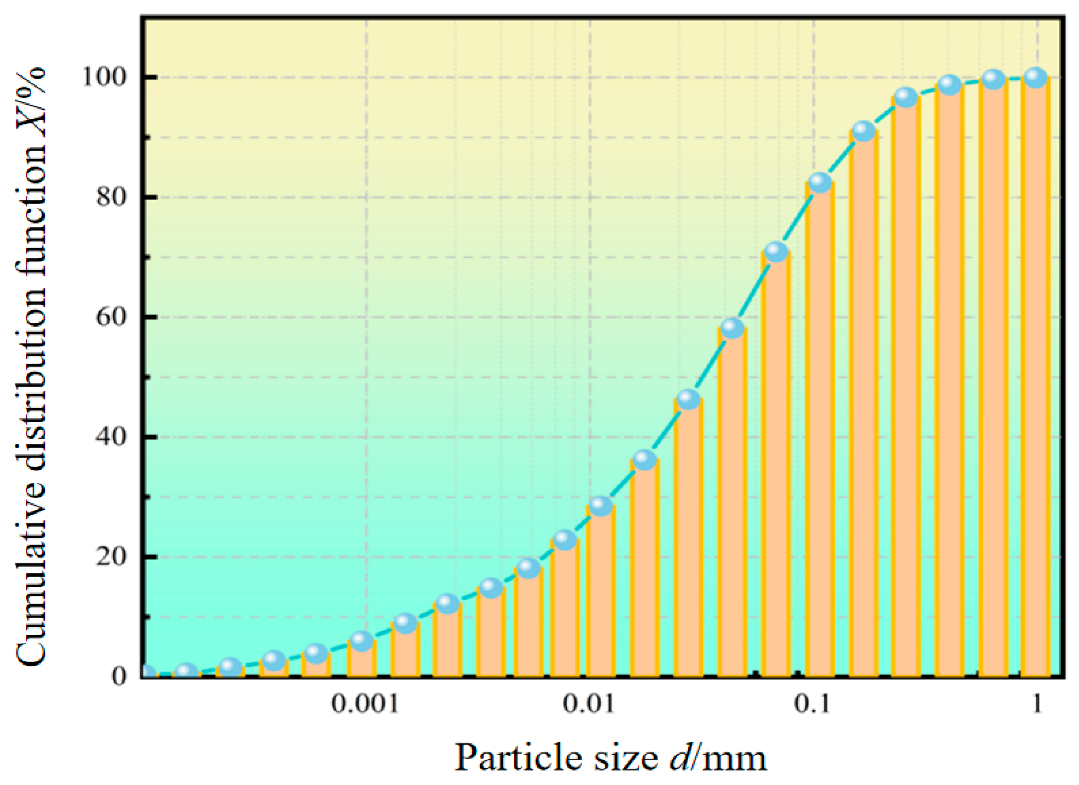
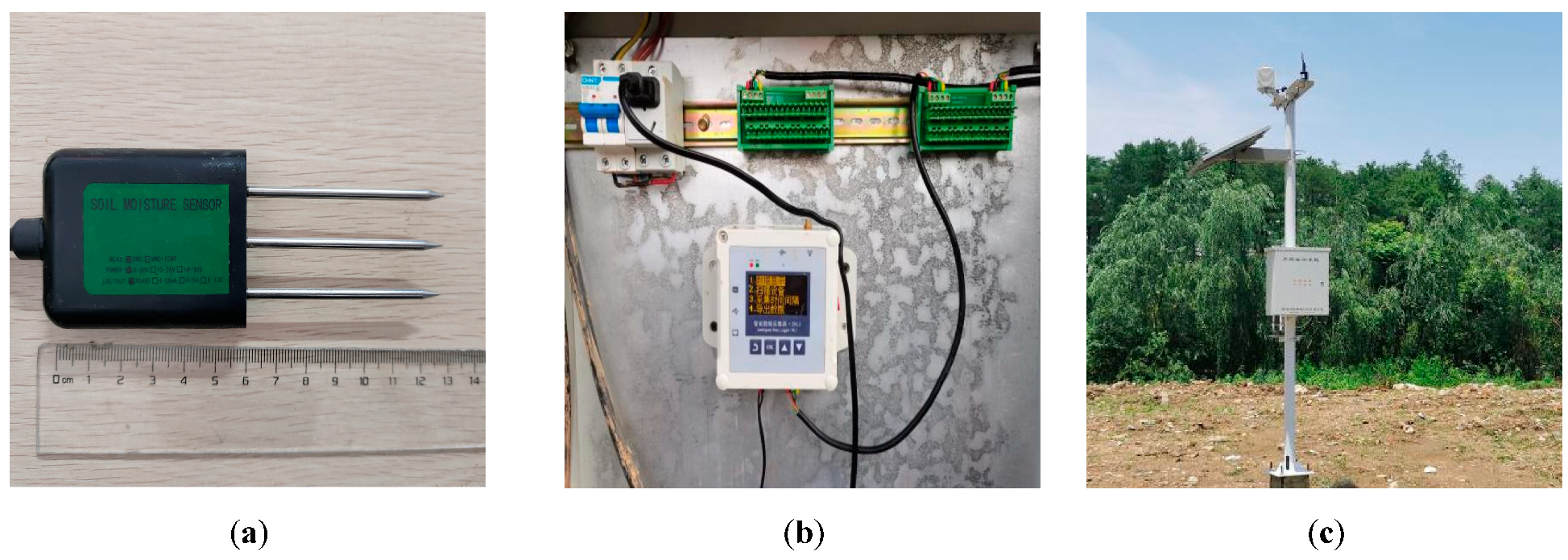
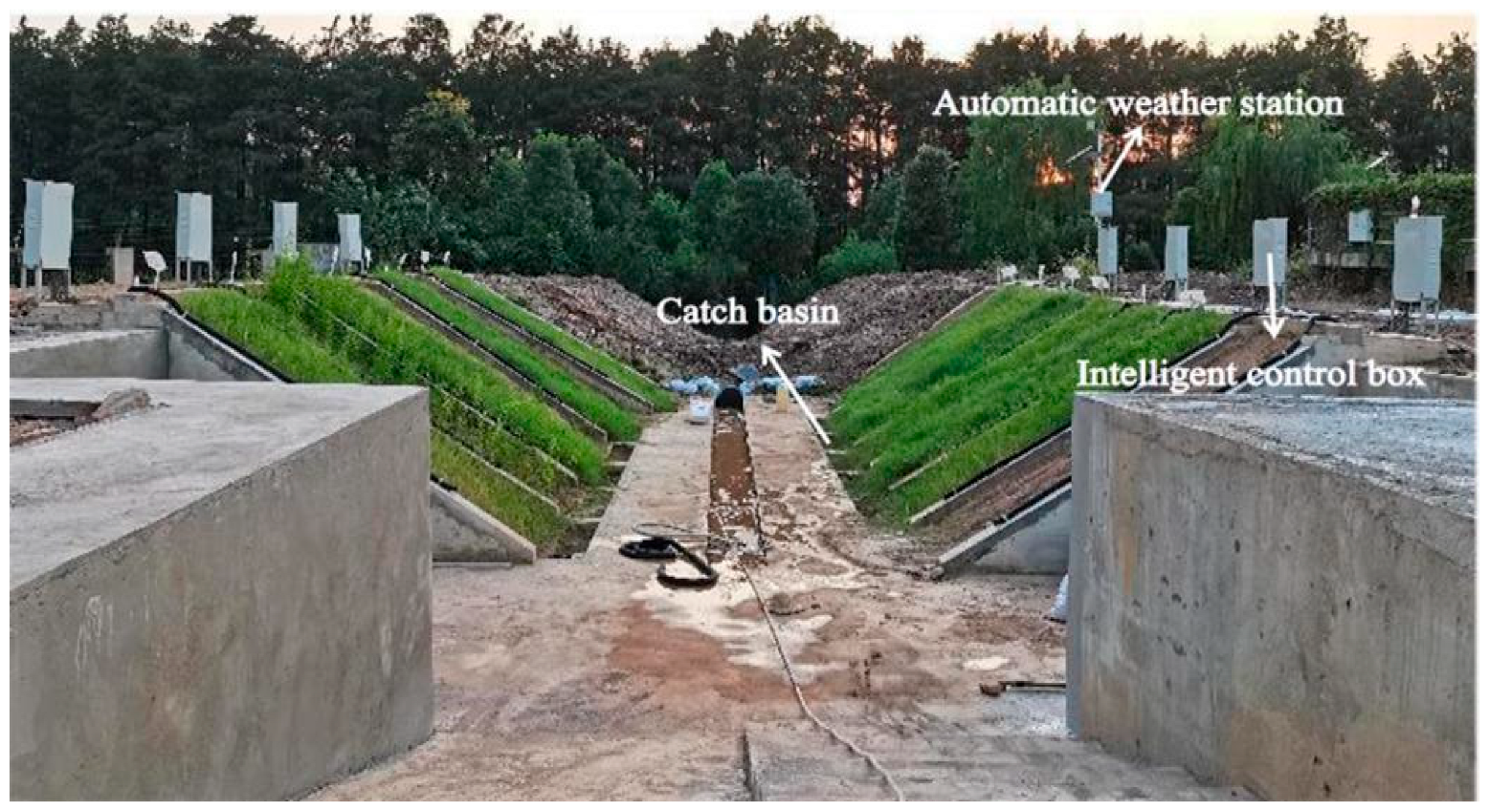
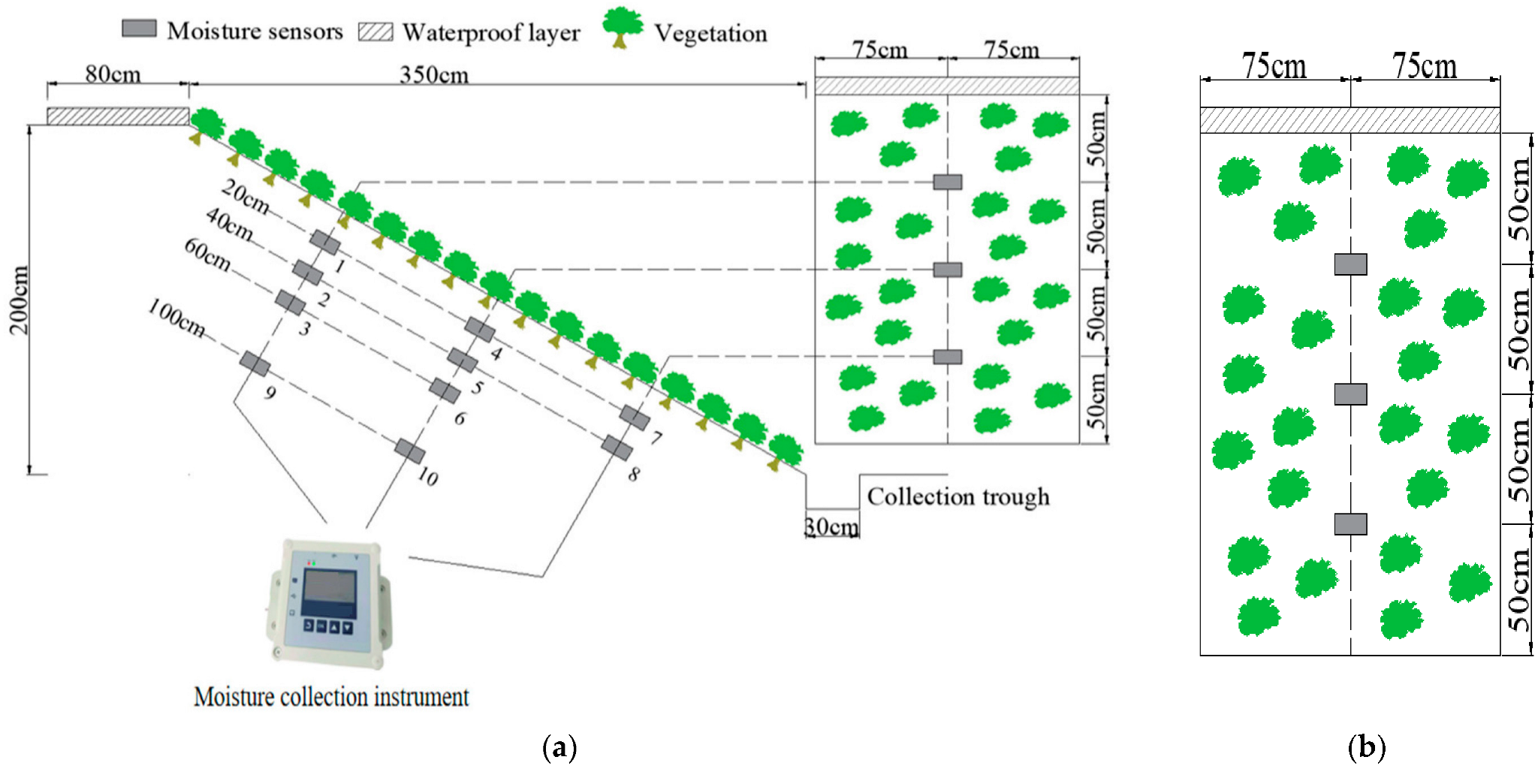

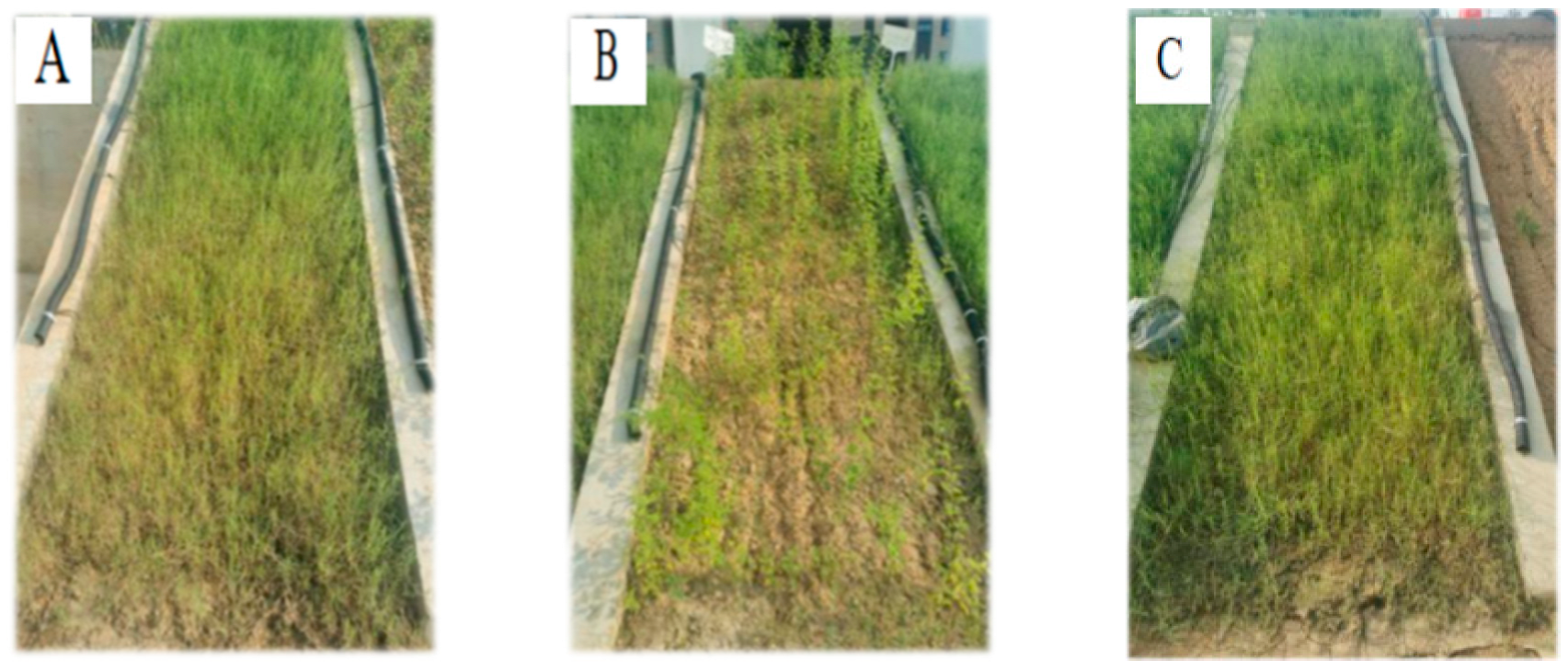

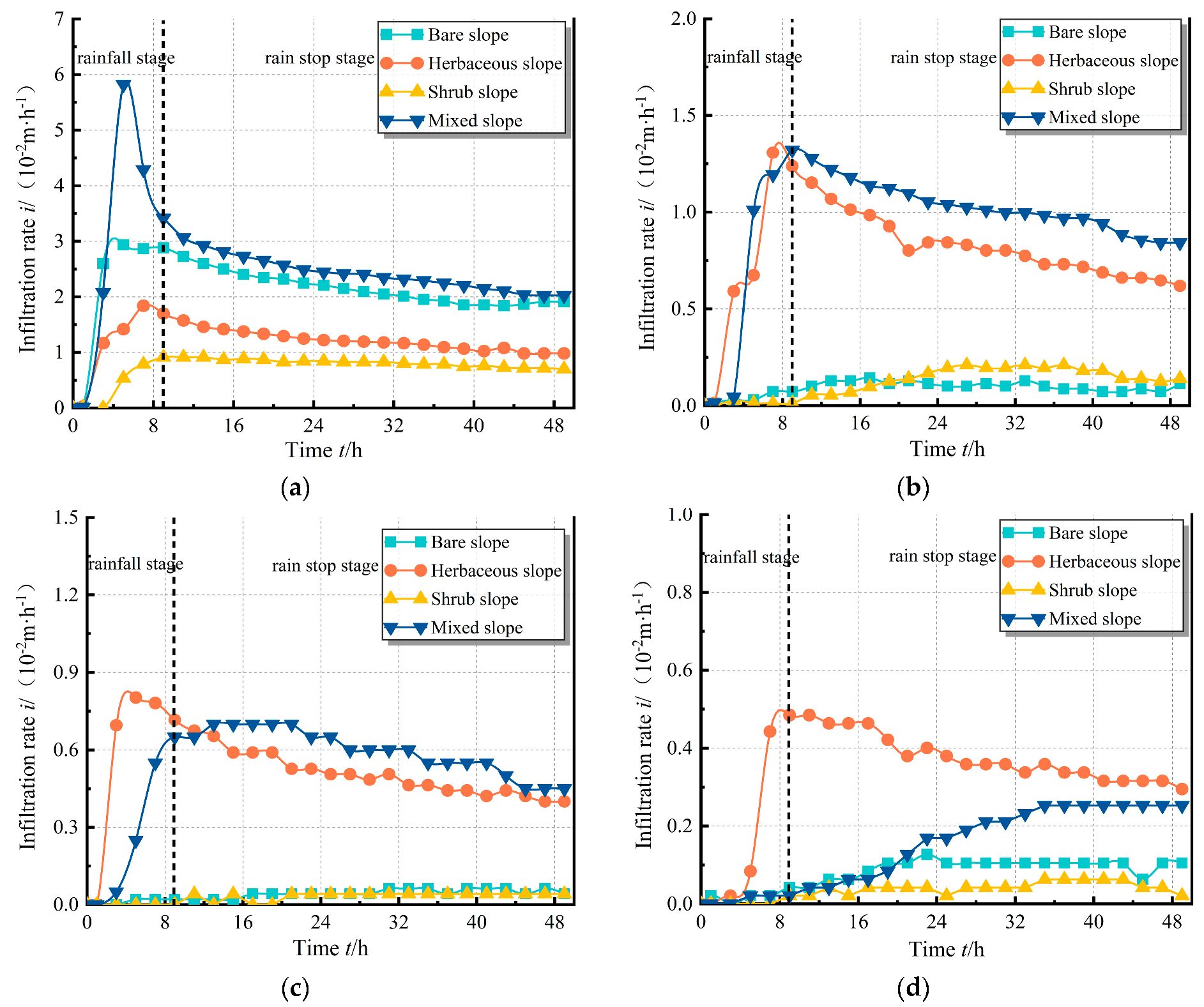
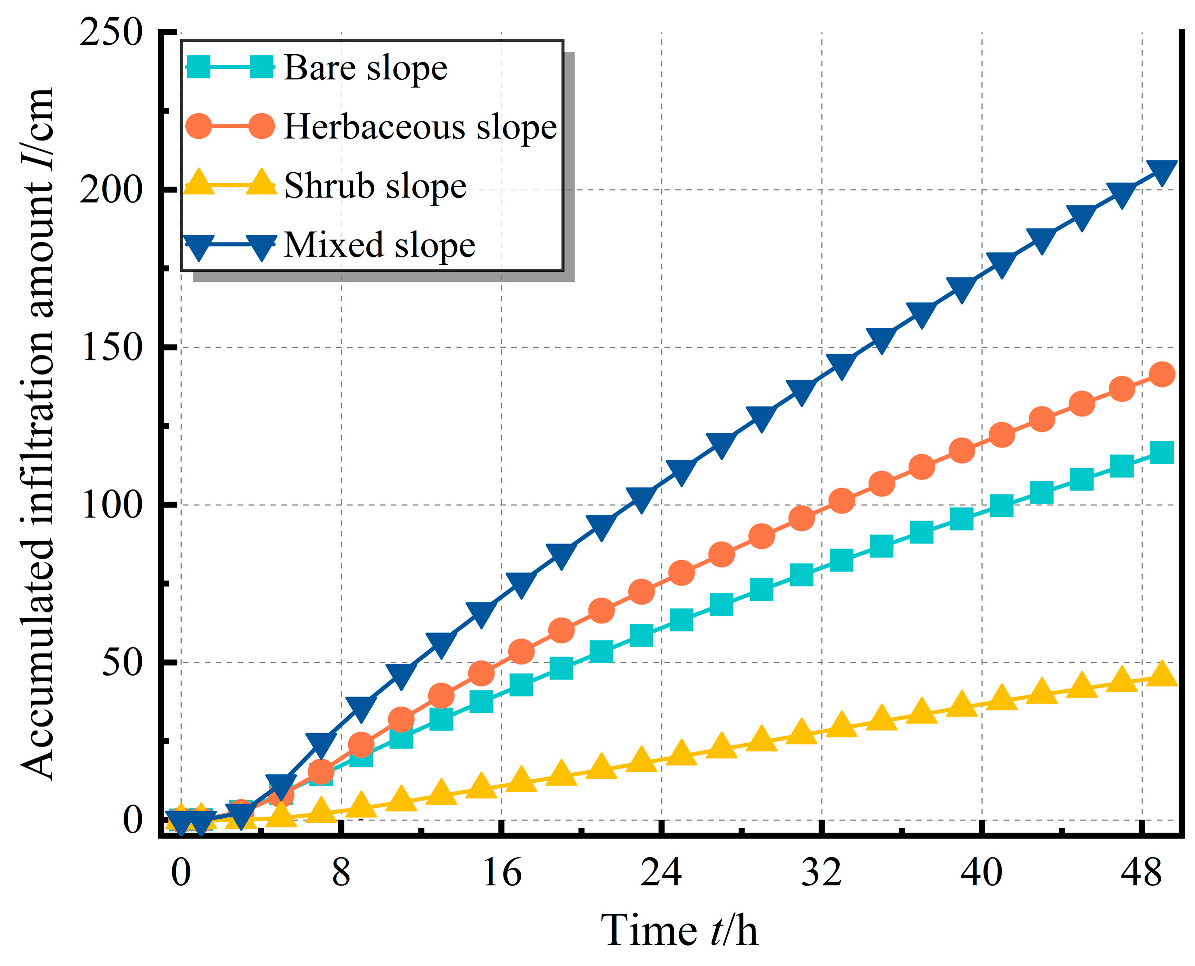
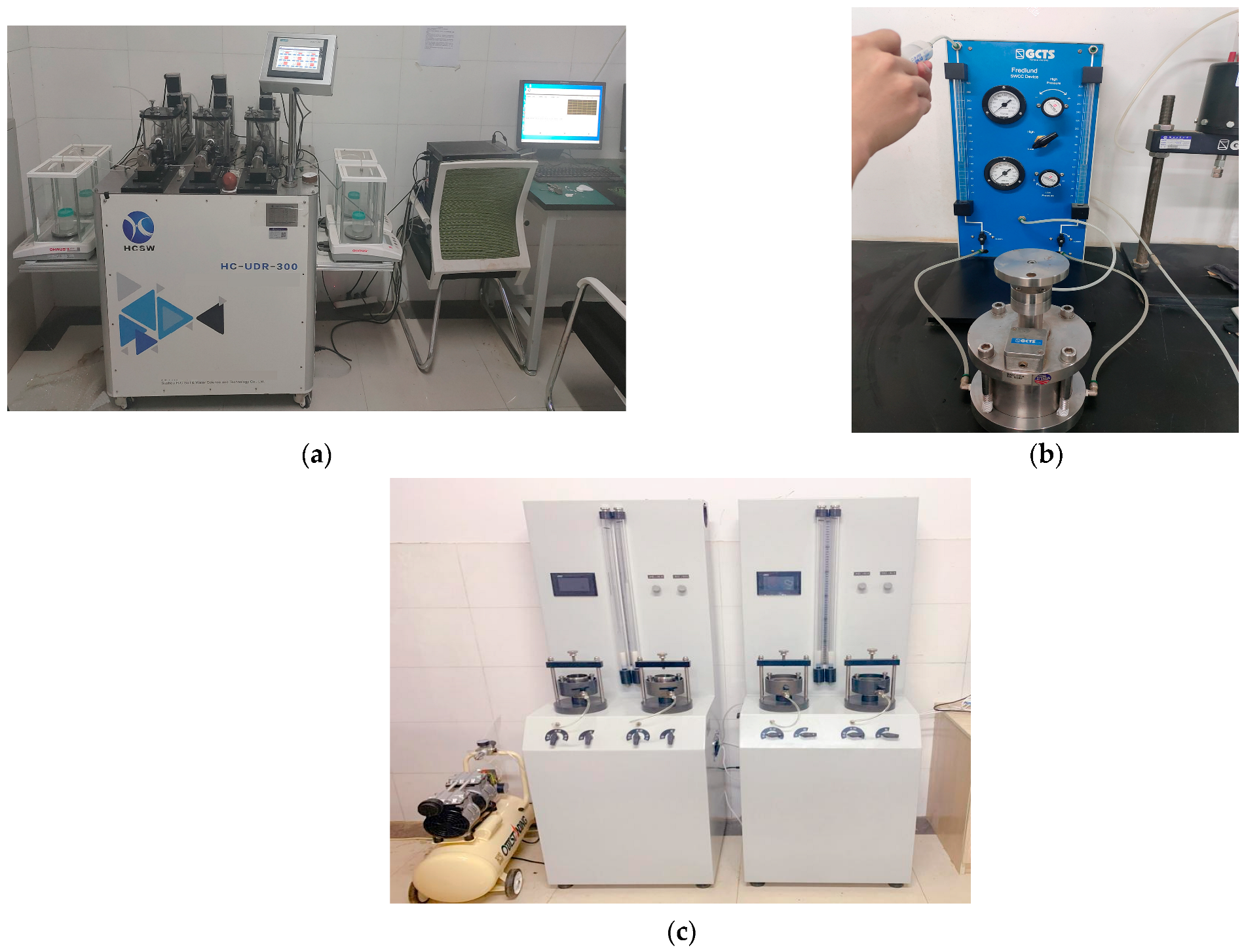

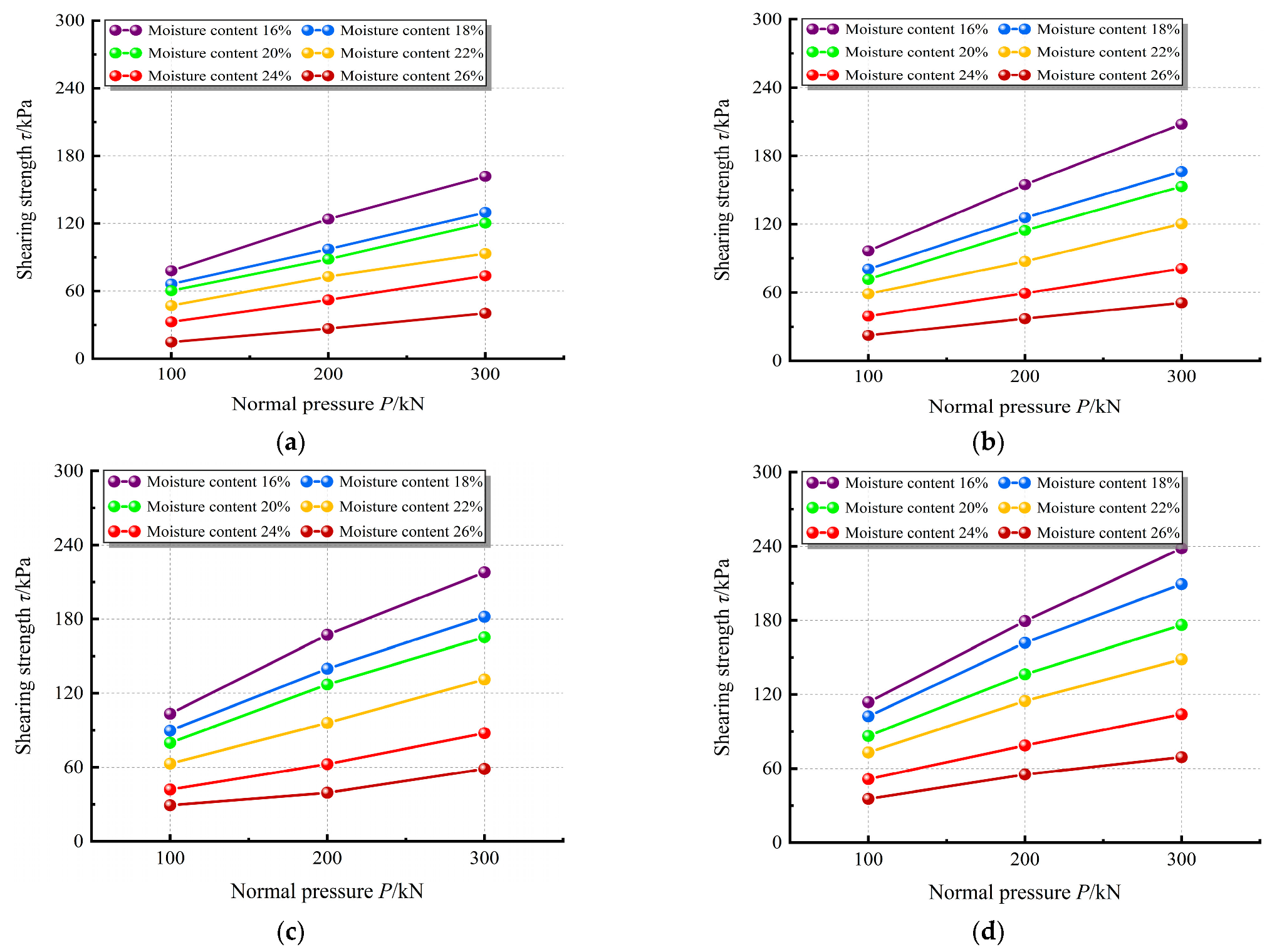
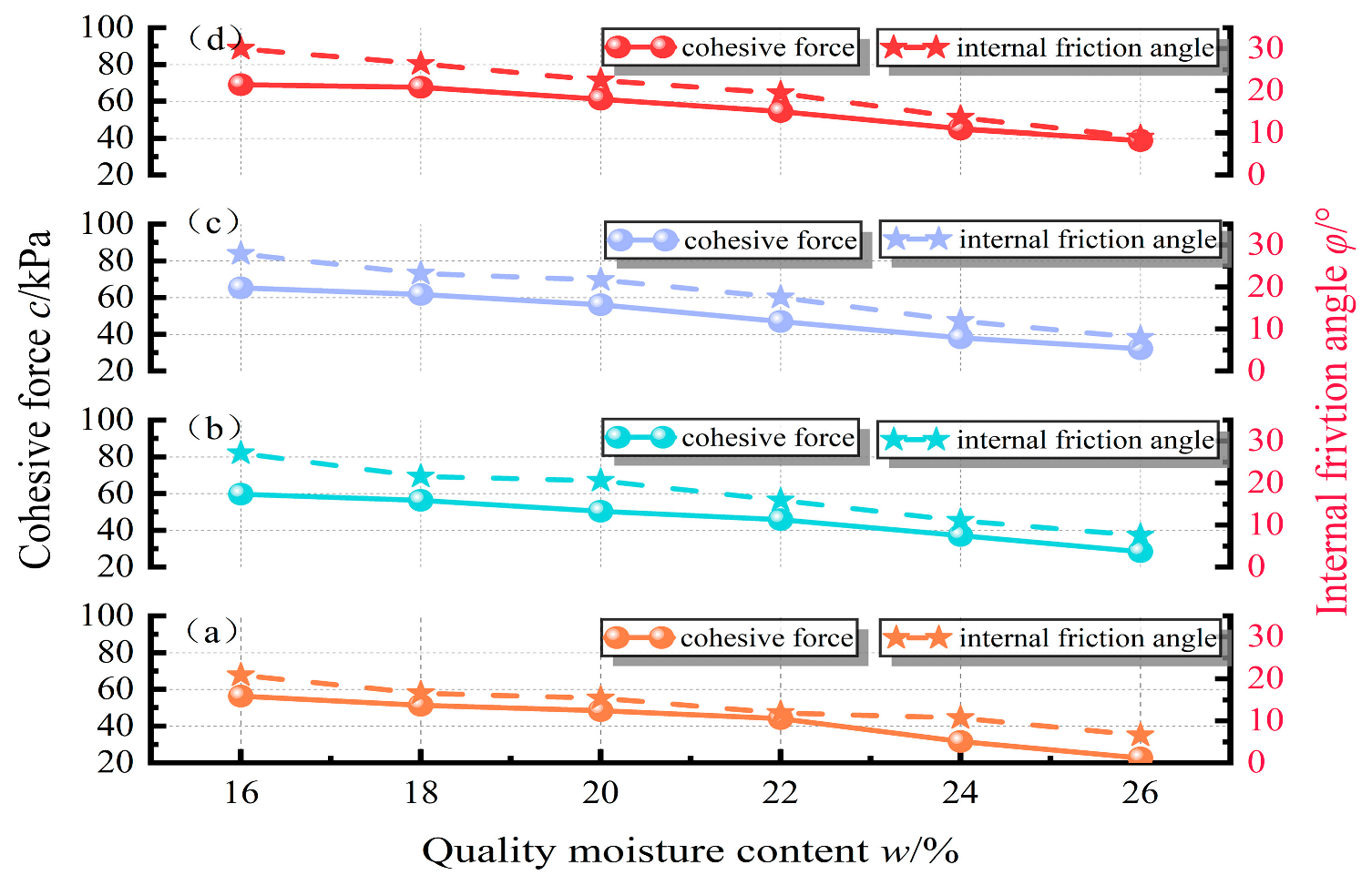
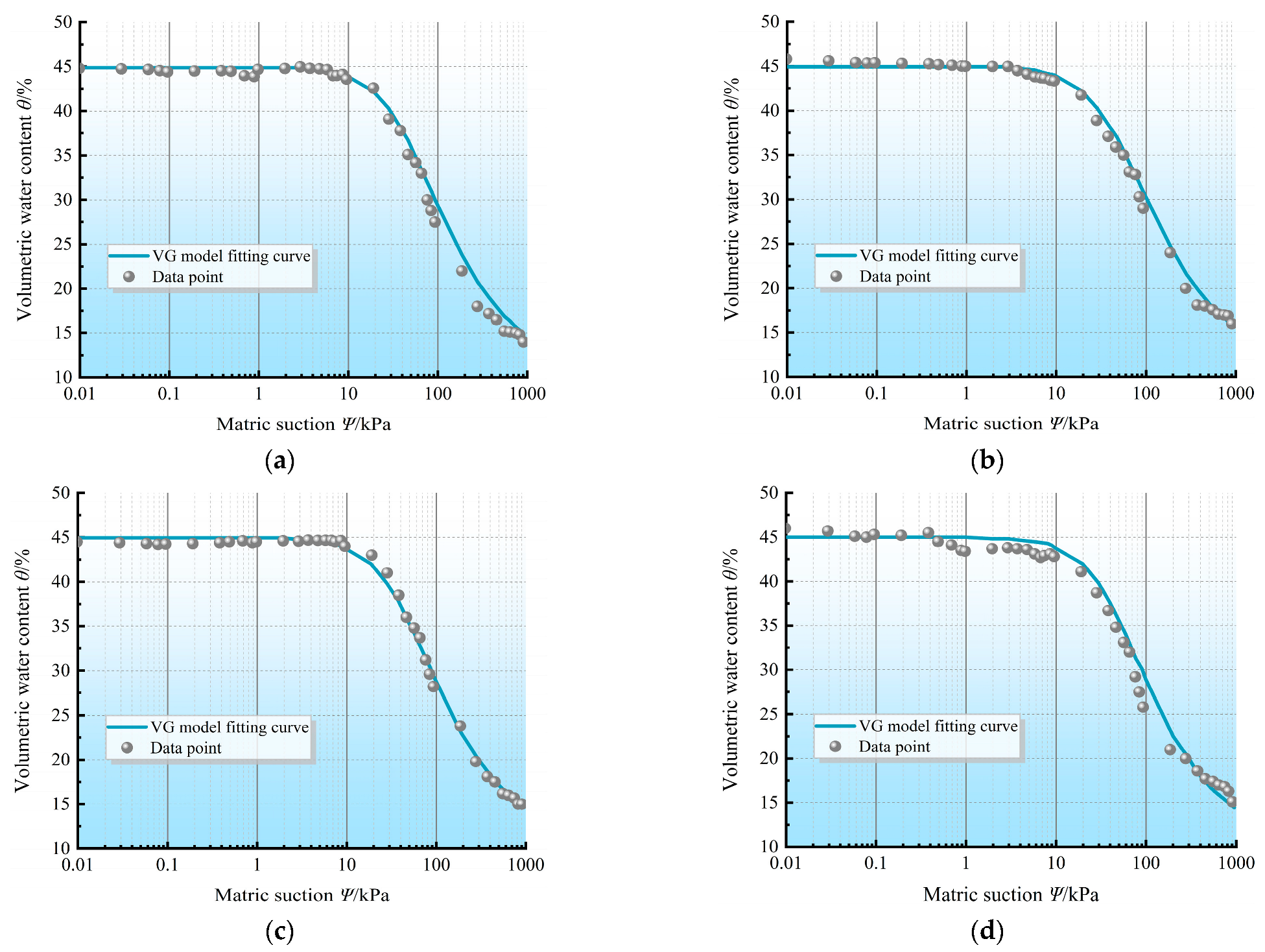
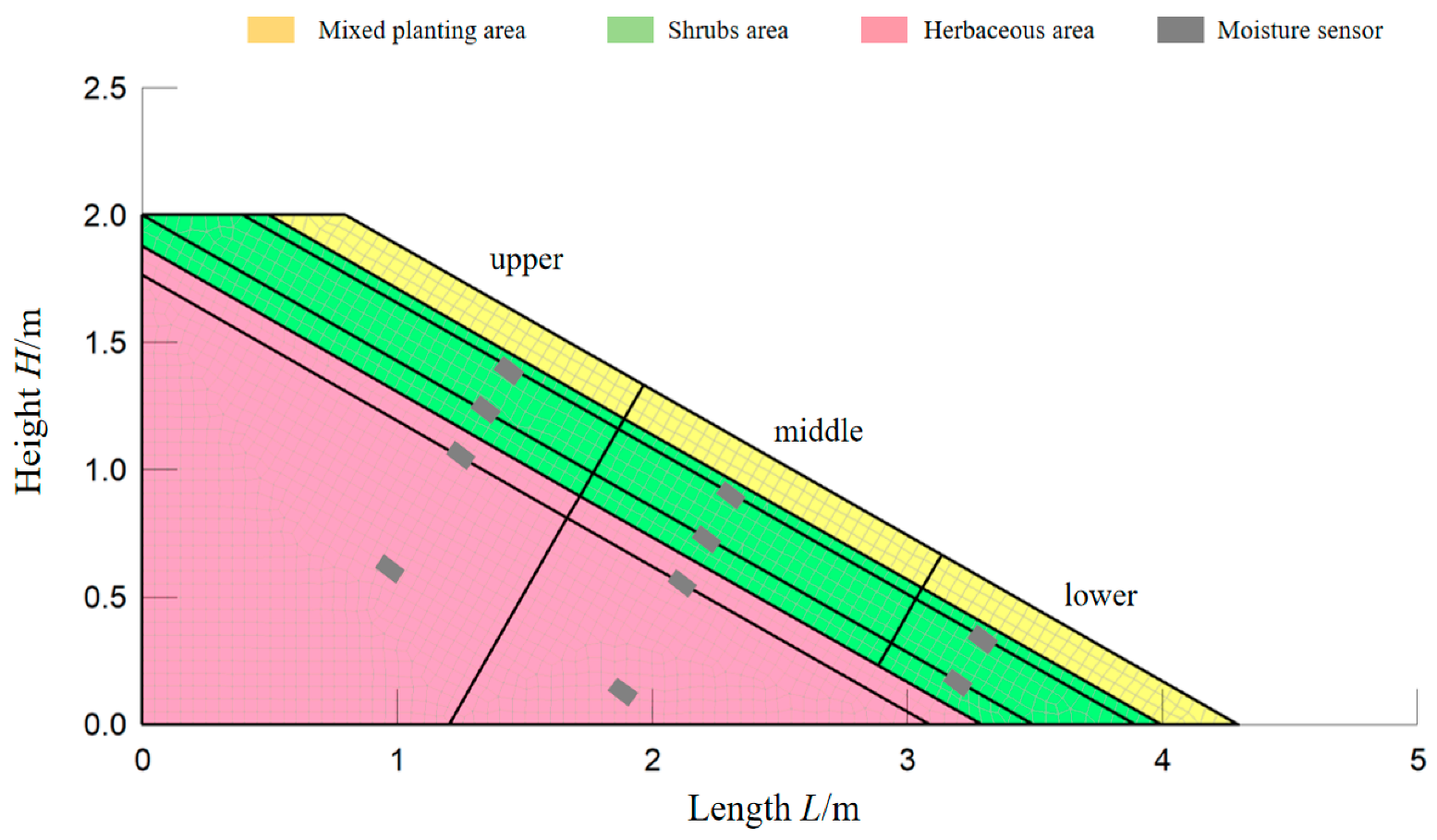
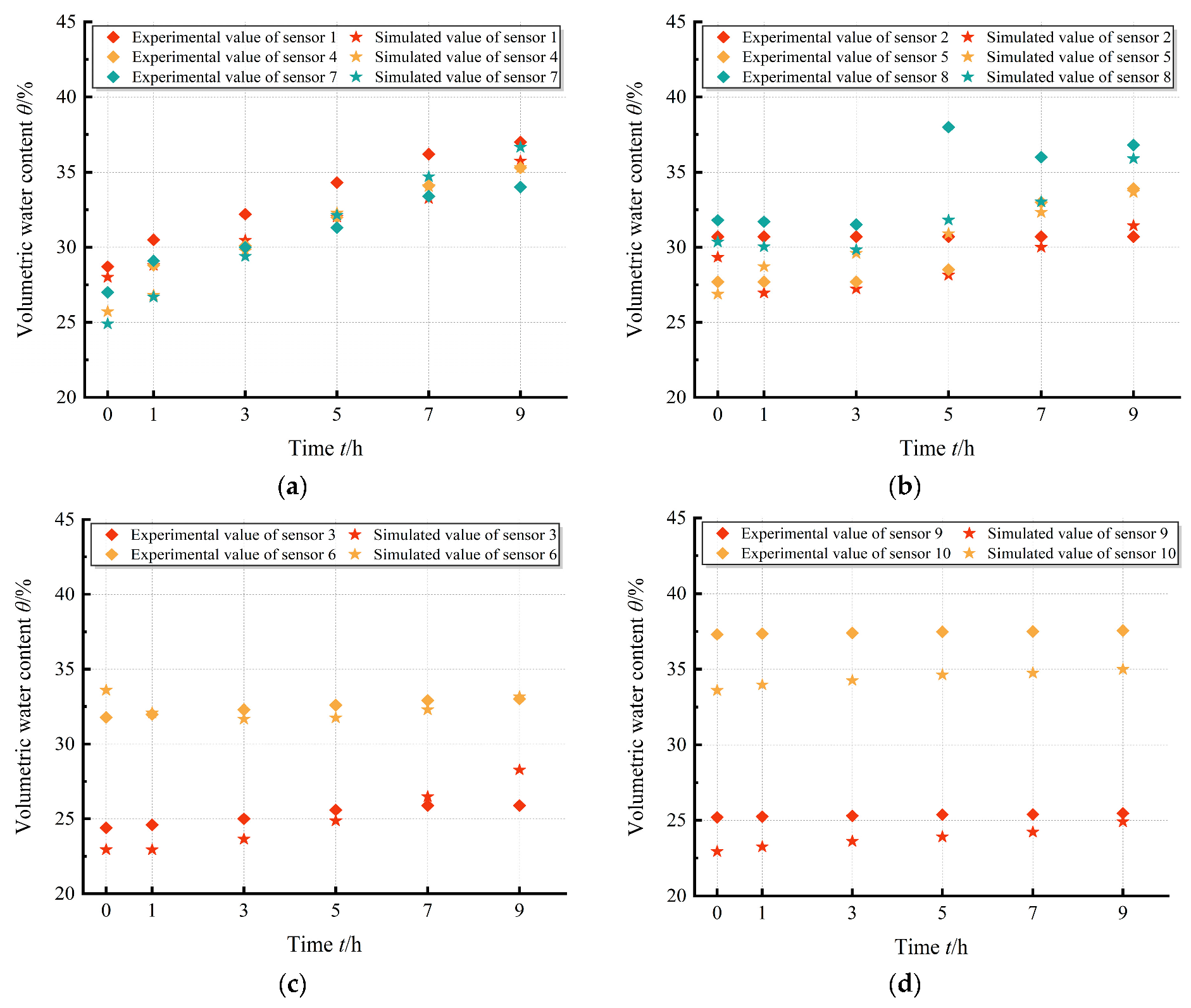
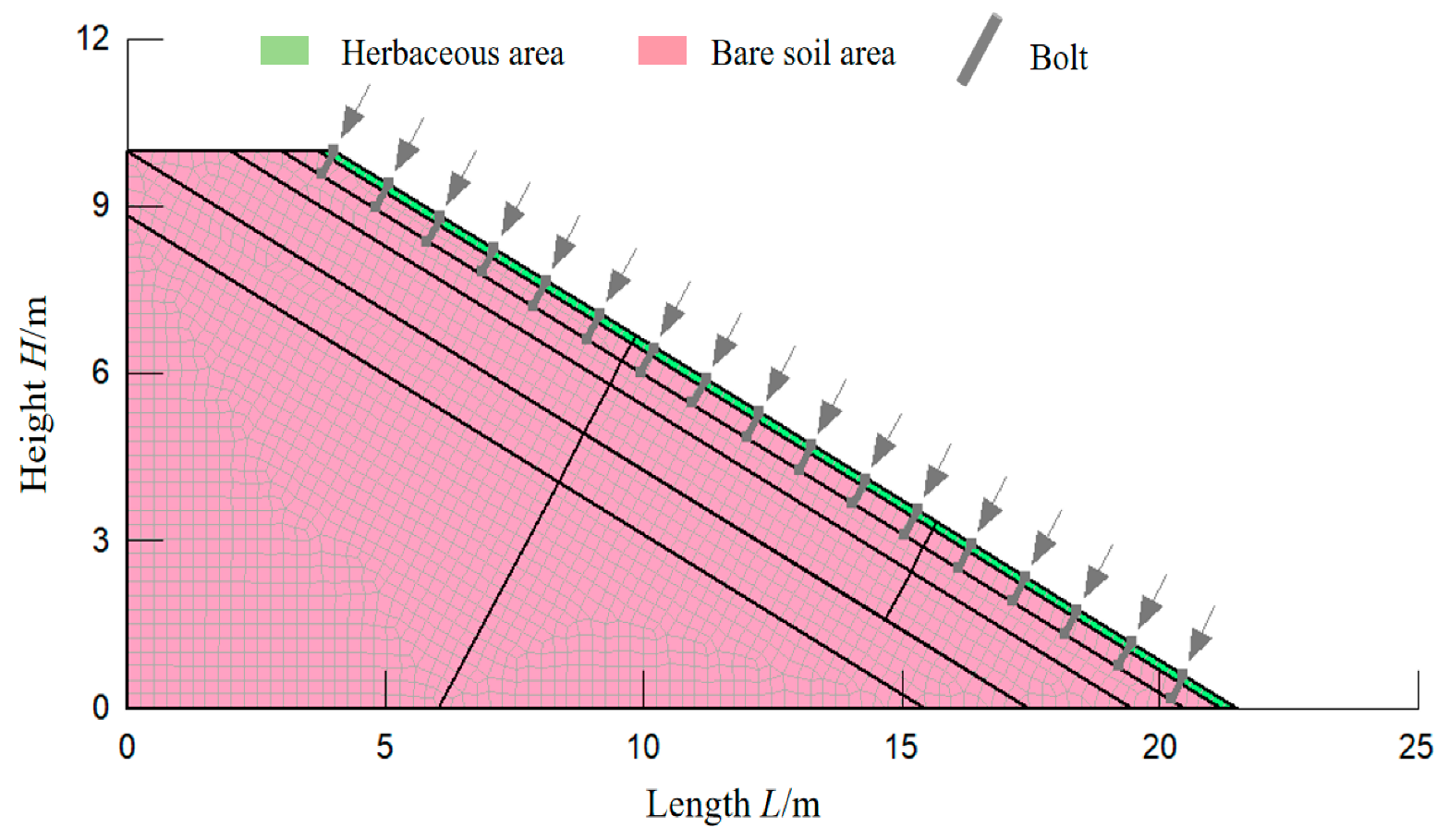
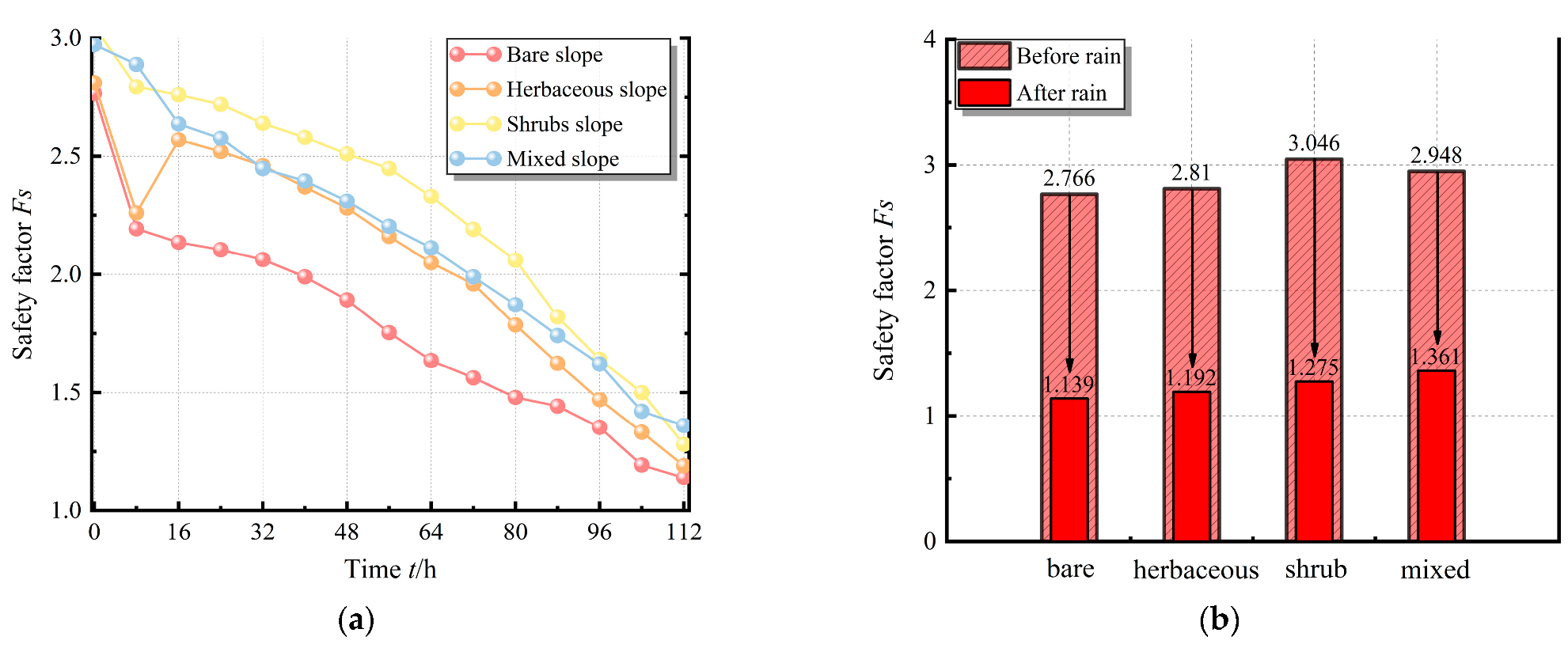
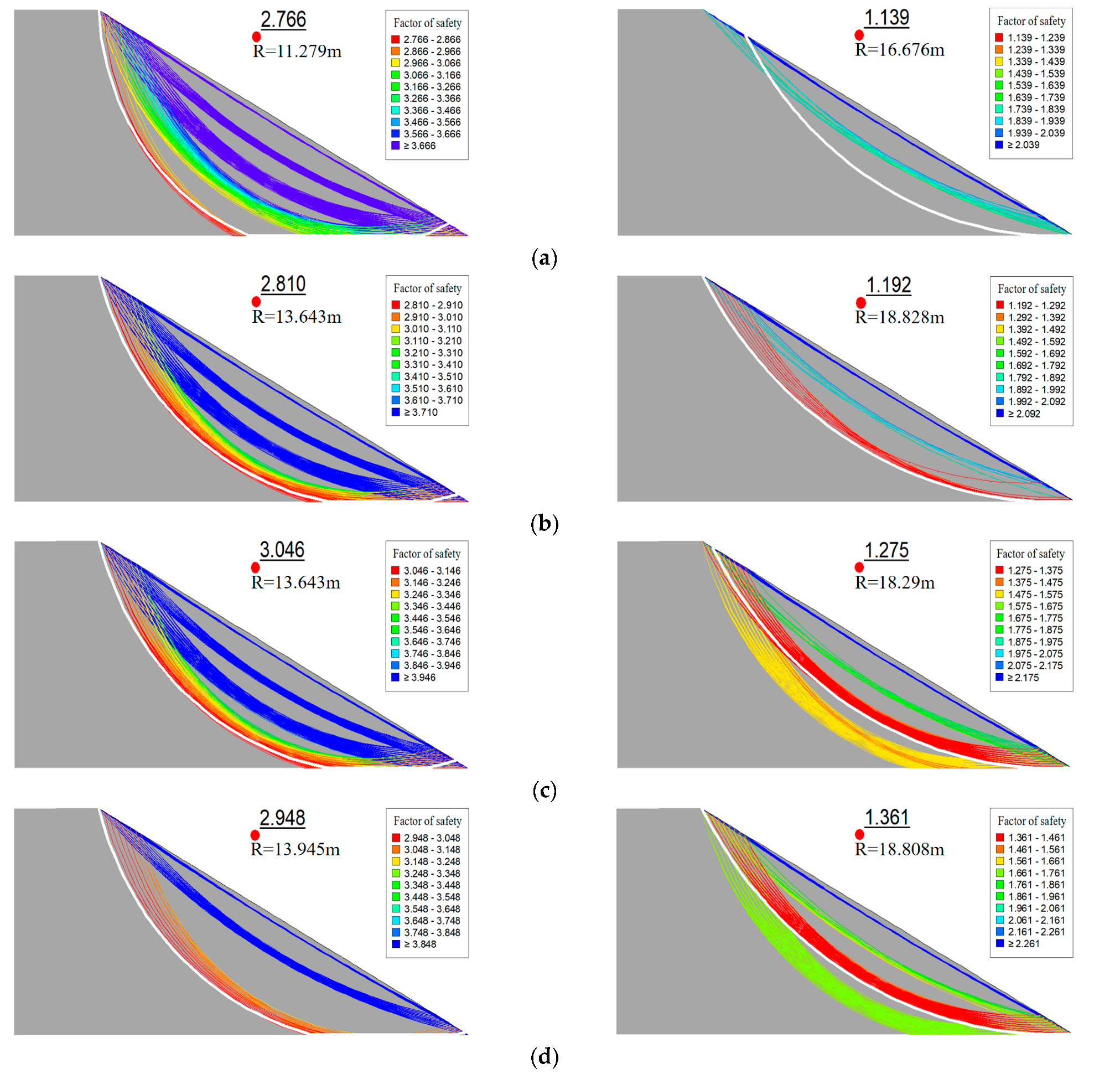
| Name | Liquid Limit ωL | Plastic Limit ωP | Maximum Dry Density ρd | Optimum Moisture Content ωop | Natural Moisture Content ω |
|---|---|---|---|---|---|
| Loam | 41% | 23% | 1.75 g/cm3 | 20% | 15.6% |
| Parameter | Range | Accuracy, A | Resolution, R | Response Time, t | Measurement Area, Am |
|---|---|---|---|---|---|
| Water content, θ(%) | 0~100% | ±2.5% | 0.1% | <1 s | Φ7 × 7 cm cylinder |
| Root Soil Type | Scale Parameter | Fitting Parameter | Shape Parameter |
|---|---|---|---|
| a (kPa−1) | m | n | |
| Bare | 50.40 | 0.395 | 1.653 |
| Cynodon dactylon | 48.90 | 0.375 | 1.600 |
| Magnolia multiflora | 45.56 | 0.388 | 1.635 |
| Mixed | 46.51 | 0.403 | 1.674 |
| Root Soil Type | Bare | Cynodon Dactylon | Magnolia Multiflora | Mixed |
|---|---|---|---|---|
| SHC (cm/s) | 2.47 × 10−4 | 4.37 × 10−4 | 4.46 × 10−4 | 4.77 × 10−4 |
| Root Soil Type | Cohesion c/kPa | Internal Friction Angle φ/° |
|---|---|---|
| bare | y = −221.45x + 112.14 | y = −88.57x + 41.57 |
| cynodon dactylon | y = −208.47x + 111.93 | y = −128.11x + 57.64 |
| magnolia multiflora | y = −234.29x + 123.87 | y = −131.39x + 59.77 |
| mixed | y = −214.93x + 123.66 | y = −139.94x + 64.22 |
Disclaimer/Publisher’s Note: The statements, opinions and data contained in all publications are solely those of the individual author(s) and contributor(s) and not of MDPI and/or the editor(s). MDPI and/or the editor(s) disclaim responsibility for any injury to people or property resulting from any ideas, methods, instructions or products referred to in the content. |
© 2025 by the authors. Licensee MDPI, Basel, Switzerland. This article is an open access article distributed under the terms and conditions of the Creative Commons Attribution (CC BY) license (https://creativecommons.org/licenses/by/4.0/).
Share and Cite
Tao, G.; Guo, L.; Xiao, H.; Chen, Q.; Nimbalkar, S.; Feng, S.; Wu, Z. Assessment of Vegetation Cover and Rainfall Infiltration Effects on Slope Stability. Appl. Sci. 2025, 15, 9831. https://doi.org/10.3390/app15179831
Tao G, Guo L, Xiao H, Chen Q, Nimbalkar S, Feng S, Wu Z. Assessment of Vegetation Cover and Rainfall Infiltration Effects on Slope Stability. Applied Sciences. 2025; 15(17):9831. https://doi.org/10.3390/app15179831
Chicago/Turabian StyleTao, Gaoliang, Lingsan Guo, Henglin Xiao, Qingsheng Chen, Sanjay Nimbalkar, Shiju Feng, and Zhijia Wu. 2025. "Assessment of Vegetation Cover and Rainfall Infiltration Effects on Slope Stability" Applied Sciences 15, no. 17: 9831. https://doi.org/10.3390/app15179831
APA StyleTao, G., Guo, L., Xiao, H., Chen, Q., Nimbalkar, S., Feng, S., & Wu, Z. (2025). Assessment of Vegetation Cover and Rainfall Infiltration Effects on Slope Stability. Applied Sciences, 15(17), 9831. https://doi.org/10.3390/app15179831







